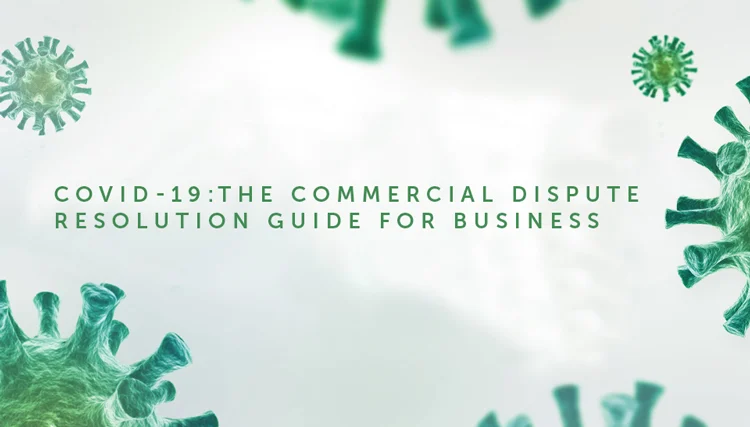
COVID-19: The Commercial Dispute Resolution Guide for Business
Published on May 26, 2020 by Selwyn Black
Disputes, Debts, and Doing Business in COVID19
The essential guide for business, directors and creditors from the Carroll & O’Dea Business Lawyers Team who are Law Society of New South Wales Accredited Specialists in Business Law, Commercial Litigation, and Dispute Resolution.
Executive Summary
- It is positive that the nation is awakening from the corona crisis coma. The commencement of incremental relaxation of some Coronavirus restrictions, early indications the economy is showing prospects of improvement and the reopening of some businesses are signs the country is moving towards a COVID-Safe stage of the pandemic.
- It is also positive that the interim measures Coronavirus Economic Response Package Omnibus Act 2020 (Cth) (COVID Act) created some much need breathing space for some debtors, via interim moratoriums, temporary freezes, and the deferral of debt recovery processes. For creditors, the COVID Act suspended their rights to recovery, which created its own dangerous centrifuge of debt which has been in limbo, for now.
- But, what now?
Winter is coming, but the end of the temporary debt freeze is fast approaching.
The COVID Act protection period started on 25 March 2020 and concludes on 25 August 2020, at which point Insolvency lawyers predict chaos to ensue. Some businesses are actively seeking advice and implementing informed decisions to resolve their business disputes now. Others are waiting for unresolved matters to happen to them.
When it matters,
you need the
right commercial advice
Three Dispute Resolution Perspectives
Whatever your situation and whatever your intention – this essential guide provides you with commercial dispute options from three perspectives:
- On the existing COVID-19 framework
- On current trends; and,
- To equip you with the tools to start exploring your options in respect of your business dispute or commercial dispute now.
1 – The COVID Act Framework
In order to understand where you want to go, you need to understand where you are. This table identifies the COVID Act amendments, and how those amendments affect your cashflow and outstanding debts.
Amendment |
Description |
|
| 1 | Temporary protection period – 21 days to six months
Extension procedure available for debtors to prevent recovery action by unsecured creditors will increase from 21 days to six months. |
Personal Debts – This means that debtors will have 6 months to satisfy a Bankruptcy Notice before a creditor may commence bankruptcy proceedings; Schedule 12, Part 1 of the COVID Act.
Company Debts– This means that debtors will have 6 months to satisfy a Statutory Demand before a creditor may commence bankruptcy proceedings; Schedule 12, Part 2 of the COVID Act. |
| 2 | Debt threshold increase | Personal Debts– Debt threshold for creditors to apply for a Bankruptcy Notice against a debtor will increase from $5,000 to $20,000.
Company Debt– Debt threshold for creditors to apply for a Creditors Petition against a debtor will increase from $5,000 to $20,000. |
| 3 | Debt response time frame increase | Personal Debt– Timeframe for a debtor to respond to a Bankruptcy Notice before a creditor can commence bankruptcy proceedings will be increased from 21 days to up to six months.
Company Debt– Timeframe for a debtor to respond to a Creditors Petition before a creditor can commence bankruptcy proceedings will be increased from 21 days to up to six months. |
2 – The Trends
In the March quarter 2020, bankruptcies were down by 15.9% compared to the March quarter 2019, according to the latest personal insolvency statistics released by the Australian Financial Security Authority (AFSA).
This could mean one of two things; either creditors are exploring alternative arrangements with debtors, or that the temporary stay has only staved off the swell of the creditor? tsunami for now. Indications from the Australian Bureau of Statistics (ABS) point to the latter.
The ABS Anticipated adverse business impacts due to COVID-19 study indicated:
- Seven in ten businesses reported that reduced cash flow (72%) and reduced demand for goods and services (69%) are expected to have an adverse impact over the next two months.
- Two thirds of businesses reported reduced demand for goods and services (64%) and reduced cash flow or turnover (66%).
These figures only related to businesses who provided a report. It is unlikely that businesses in severe financial distress responded or provided data.
3 – Your Options
Now more than ever businesses need to be aware of their options to explore, why they should (the advantages) and any possible consequences (the disadvantages). Here is your non-exhaustive guide:
Option to Explore |
Advantages |
Disadvantages |
|
 |
Pre-litigation enforcement procedures (such as show cause, default notices and letters of demand and correspondence).
|
Parties preserve and exercise their rights. Crystallises the dispute, and their position. |
Options for resolution are limited.
|
|
|
Involuntary Bankruptcy Processes(such as Bankruptcy Notices or Statutory Demands) |
Useful in undisputed debt recovery processes to start the involuntary bankruptcy process of appointing a trustee or liquidator by court order. May be faster and cheaper route, if undisputed. |
If disputed, may create additional litigation in disputing solvency, the debt or other existing claims. |
|
|
Commence proceedings |
Some circumstances require urgent injunctive relief restraining certain conduct, freezing orders, seizing or searching goods or property. Obtain court orders that can be enforced against the target, property or goods. If successful, you can obtain orders and costs against the other party. |
Costs of proceedings Risk of Litigation. Risk of adverse cost orders, if unsuccessful.
|
 |
Insolvency, Restructuring and Turnaround Options |
May protect Directors from personal liability vis a vis duty to prevent their company from trading whilst insolvent through safe harbour provisions. May generate a profit or sale of the business that provides a return to creditors. May generate capital through debt to equity or other options or structures. Opportunity to explore other voluntary bankruptcy options such as voluntary administration, Deeds of Company Arrangement or debt agreements. |
May result in voluntary bankruptcy measures such as external administration. In the event of external administration, directors and officers of the company may be investigated and subject to stringent powers of investigation by a third party. |
|
|
Business Regulation and Governance
|
Enhance existing systems and examine employment resources. Potential insurance premium reductions and review existing insurance coverage. Explore refinancing loan facilities. Aged Debtor regulation tightening. |
This may not address all external issues.
|
|
|
Explore Taxation Relief Benefits, and Government Interim Relief |
Access Australian Taxation Office (ATO) measures to help individuals and business, such as government payments to individuals and business, i.e. tax write offs, access to superannuation, and accelerating depreciation deductions; direct link to ATO support here. |
Does not address issues after COVID19 and maintaining profitability.
|
 |
Mediation, and Alternative Dispute Resolution |
Explore good faith negotiations, and mediation requirements COVID-19 Leasing Regulations. Allows parties to negotiate either without assistance from a third party, or with a third party neutral mediator who can facilitate resolution, Less restrictions on the options available to parties. Explores other ways of resolving issues in dispute, which may be binding such as arbitration and expert determination. |
The decision is only binding, if agreed by both parties (this can also be a positive because there is little downside to attending mediation).
|
|
|
Negotiating “Opt In” arrangements |
Explore smoother exit arrangements from the transaction, lease, contract or business with transparency. Parties can agree on what dispute resolution processes shall apply in the event of a dispute (mediation, arbitration, expert determination). |
The decision is only binding, if agreed by both parties. |
|
|
Structuring “Opt In” continuing supply agreement |
Explore business opportunities to create further business, services or value. Mitigates exposures through provision of security arrangements, credit terms, guarantees, security bonds or assets. Parties can agree on what dispute resolution processes shall apply in the event of a dispute (mediation, arbitration, expert determination). |
The decision is only binding, if agreed by both parties |
How do I know which option to use?
It depends on the circumstances of your case.
However, often the best results are achieved by using a blend of these approaches which requires an intimate knowledge of these perspectives.
It matters to have experts with the skills, experience and determination needed to put your business first, in a highly competitive world. Our lawyers act for all types of enterprises from large corporations through to family companies at every stage of the business life cycle.
Our lawyers have particular expertise in property & development, services and healthcare industries, construction, manufacturing & distribution, logistics, and in IT and other innovative sectors.
What do I do now?
We look forward to exploring your options with you. If you have questions, please contact our office on 1800 994 970 or enquiries@codea.com.au. If you are a new client, please complete our Contact Us Form now, so that one of our experts can contact you with a no charge and no obligation call to see how we can help your business now.
